Aryan Tauqeer reviews John Hyams’ pandemic slasher film.
When Wes Craven’s seminal Scream hit theatres in the winter of 1996, it represented the birth of not just the director’s second generation-defining slasher series after A Nightmare on Elm Street, but the inception of a mode of metatextual horror. The archetype of the post-millennium slasher, established by Craven, had been raised by years of Halloween and Temple of Doom VHS tapes worn countless times over, for whom the language of the knife tearing through the shower curtain was as natural as speech, and for whom the masked silhouette looming in the shadows was as common a sight as the walls behind it. In the years that followed, countless imitators for whom Scream had represented a paradigmatic shift in genre attempted, to varying degrees of success, a recreation of the undeniable cultural phenomenon that was Scream– not least Craven himself, whose cinematic swansong Scream 4 wrestled with the collective exhaustion induced by the postmodern slasher by contextualizing it against a younger, deadlier generation’s acute knowledge of how to wield the image as a weapon. A year ago, the first entry in the franchise without Craven at the reins, the maddeningly titled Scream, was perhaps the most exhausting of all the members of the original Scream’s iconographic lineage. That film’s inability to inject an iota of tension or creativity in its perfunctory dispatching of its hollow shells of “characters” was matched only by a marginally more embarrassing attempt to comment on a nebulously defined conception of “toxic fandom”, where its total absence of formal ingenuity was excused by displacing the source of inevitable criticism onto genre obsessives.

Fortunately for the dying husk of the slasher, however, there continue to exist practitioners of the genre who imbue it with a potency that belies the two-and-a-half decades of postmodern wringing that followed. Among these practitioners is John Hyams, son of genre maverick and frequent JCVD collaborator Peter Hyams, and whose latest stab at the slasher, Sick, melds piercing contemporaneity with the sort of formal rigor that seemed all but lost in the genre. Filmed during the COVID-19 pandemic, the film taps into the parasitic paranoia induced by mass quarantining by, rather ironically, sequestering its leads Parker (Gideon Adlon) and Miri (Bethlehem Million) away into a riverside holiday home that Vincent Hanna might describe as a “dead-tech postmodernist bullshit house”. The relative idyll of their trip away from mandatory masking and social distancing, however, is pierced by the arrival of a barrage of vaguely-threatening texts from an unknown number, suggesting that they are being watched at all times. If this situational milieu sounds all-too-familiar to the aforementioned Craven slasher series, it’s because Sick is written by none other than Kevin Williamson (along with Katelyn Crabb), the scribe for the first, second and fourth entries of the Scream films, as well as Craven’s Cursed (the latter of which is perhaps most famous for its notorious mutilation in the edit by Harvey Weinstein). Since it was quietly added to last year’s Toronto International Film Festival’s (TIFF) Midnight Madness lineup, the prospect of the director of the magnificent Universal Soldier: Day of Reckoning and the writer of the Scream series collaborating on a slasher rooted in present-day paranoia has been a source of enormous anticipation for this writer. In practice, the melding of Hyams and Williamson proves to be less a harmonious synthesis than an often uneven jury-rigging of Williamson’s acerbic teenage drama with Hyams’ brutal simplicity of form. Notwithstanding its ill-considered attempts at rendering its motivations politically sound, the film distinguishes itself from its genre contemporaries by maintaining the tautness of its tension, with refreshingly little else on its mind besides successively more desperate carnage.
Much of what lends the film its potency is its swiftness in dispensing of expositional formalities, opening with a wordless brawl in a frat house that recalls Hyams’ DTV action roots. As much of his utilization of unbroken long-takes spanning across planes of action is relied on to the point of perfunctory repetition, the jolting kineticism of these sequences ensures that every thud of a skull landing on hardwood oak and snapping of femurs land with resounding brutality. These sequences, moreover, are woven into a wider, breathless string of movement that scarcely relents once it begins- even the bare minimum of exposition that Williamson’s script adheres to, in the form of the leads’ exploration of the resort that is soon to become a mausoleum, navigates a consistent web of spatiality that telegraphs the glaring strains on both the house’s security and Parker and Miri’s friendship. As opposed to much of the past year’s cinematic engagement with lockdowns and masking, Sick relishes in the blatant dismissiveness of its privileged youth towards the pandemic, lending a degree of obliviousness that makes the arrival of masked figures at their doors all the more compelling, and satirizing pandemic-era pastiche in a manner far less jarring than other recent entries in satires of the disgustingly wealthy (i.e. Glass Onion). Particularly pertinent is its situating of masks, an environmental necessity, as a tool of amplifying tension, using the social faux pas of not wearing one as part of its paranoia- when Miri is denied entry into a stranger’s car because of the absence of a mask enshrouding her face, the imminent arrival of a bruised and bloody assassin becomes comically prolonged in a manner that recalls the cold open to Williamson’s Scream 2.

What fundamentally distinguishes Sick from a recent spate of teen slashers, however, is not its social commentary, which stumbles towards the film’s third act- it is the fact that Hyams appears to understand that the frame is the object, as opposed to a canvas for the intellectualizing exercises that his contemporaries are so fond of (among which Aster is perhaps the most notable offender). Following upon this conceptualization of the frame as a distinct spatial entity with limits and possibilities, then, the film maximizes its potential by disrupting the precision of its carefully-plotted geography, whereby the wearing-down of trappings of luxury are reflected as the wearing-down of bodies by successively improvisational tools of violence. Initiation of this successive series with the intimidating yet not outlandish image of masked assailants clad in all-black and armed with knives and baseball bats establishes a foundation for a seemingly even playing field, where there exists briefly the prospect that the distinctly human home invaders may be dispatched swiftly- before, of course, the trappings of luxury become the instruments of their doom. This prolonged maintenance of tension is perhaps best exemplified when a bloodied, but still walking, victim seems to stumble out the doorway towards freedom, until an excruciating pan from the body to the interior of the house reveals that their corpse is merely being puppeteered with an exceedingly long fireplace poker, jammed into their chest. Its images recede into the outdoors as an expanse of ostensible safety, not unlike the brief reprieve from the never-ending cycle of bloodshed in Universal Soldier: Day of Reckoning in the form of a boat gliding its taciturn protagonist across a stream of viridescence. In Sick, though, the nocturnal expanses hollow out the frame of any potential distractions beyond the hunter and hunted to an almost Bressonian degree. This reduction of the hunt to merely conflicting geometry often results in cinematographer Yaron Levy’s images capturing something deeply primal in unremarkable simplicity- the rapid piercing of the gaps in between the planks of a wooden raft by a knife, as ostensibly absurd as it may seem, is as unsettling as it is in the moment precisely because it physically isolates Parker and Miri from anything except their surroundings.
Hyams’ minutely-calculated formal precision, however, is often tantalizingly close to approaching the artful rending of flesh and bone that characterizes his oeuvre but never quite indulges in the atrocity exhibition it offers the possibility of being, restrained by both its conceptual limitations and Williamson and Crabb’s often needlessly dense characterization of the killers’ identities and their political impetus- particularly because this denouement interrupts, rather jaggedly, an otherwise ruthlessly efficient engine of suspense and impressively tactile close-quarters stuntwork- a slasher reduced to its barest.
Watch the trailer for Sick here:




